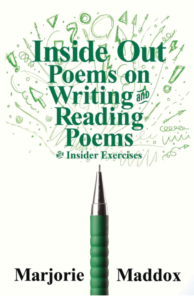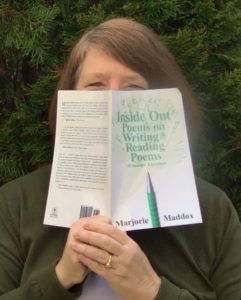“Opening the Door: How Stepping Inside the Poem Can Help Your Students—Even Those Who Hate Writing— Read, Understand, Create, and Enjoy Poetry”
Let’s face it: Some students LOVE poetry. It’s their secret passion, guarded closely. They scribble it in notebooks. They sneak-read it between classes.
For others, it’s a public proclamation. They sing poetry, dance it, prance with it around the classroom while reciting it. They raise their hands and volunteer their favorite authors.
However, for many students, well, there’s not so much love. For them, poetry resides in a decrepit, old, locked house AND someone has thrown away the key. No way are they even walking up the front path.
If any of this sounds familiar, read on. Based on my thirty years of teaching poetry at the primary, secondary, and university levels, Inside Out: Poems on Writing and Reading Poems with Insider Exercises brings together the eye-rollers, the proud enthusiasts, and the quiet creators. How? By inviting them all inside the poem.
First, unlock the door, then throw away the keys: Not the keys to fun and understanding (we’ll keep those), but the keys that say here’s a list of jargon to memorize, or here are the only subjects that poetry can be about, or here are been-there-done-that worksheets, or here’s a book with dry, lengthy explanations of those terms and exercises.
I’ll bet that most of you have already done just that. But now what?
Why not first approach poems with, well, an approachable poem? Poems, of course, are not the enemy, but some students feel that way. Here’s a helpful—and fun—way for students to “get to know” a poem.
Befriending a Poem
Invite him home for dinner,
but don’t insist on rhyme;
he may be as tired and as overworked
as his distant cousin Cliché.
Best to offer intriguing conversation
that’s light on analysis.
Allow for silences and spontaneity.
Most importantly, like any good friend,
be faithful and patient;
remember to listen.
Sometimes he’s shy
and just needs a little time and coaxing.
Much of what he has to say
lies between the lines.
Students can choose a poem they’d like to get to know, then take that poem somewhere they themselves like being (the mall? a skateboard park? a soccer field? a cabin? a concert?). Next, interact. Try having them start with one of these titles: “Inviting a Poem to My House,” “A Poem Texts Me and Says,” “Talking Back to a Poem.” You try it, too!
Next, open the door—wide! Getting to know (and write) a poem is a hands-on experience. I like to start with Inside Out poems “How to See a Poem,” “How to Hear a Poem,” “How to Taste a Poem,” “How to Smell a Poem,” and “How to Touch a Poem.” Students then write their own versions. What fragrance does a poem have? What color is a favorite poem? What does a poem taste like?
How to Smell a Poem
First, inhale deeply and equally.
Your nose, noble and brave,
knows how to adjust to each form
of aroma. Still, when you dive
into scent and swim about
until you’re wet with the whiff
of each syllabic drop,
try not to sneeze when the breeze of ballads
becomes the breath inside your lungs.
Be forewarned: the incense of words intoxicates.
There’s a peppermint odor to odes
and no lemons, no melon emanates from palindromes.
As for lack of predictability, free verse is the worst:
who knows what stench will attack the old olfactory,
what fragrance will rejuvenate your young but numb nostrils?
That’s the adventure to savor in this flavor extravaganza.
Keep following the trail of scent to sniff out the meaning.
These initial interactions then “open the door,” not only to sensory details, but also to such poetic tools as couplets, personification, alliteration, similes and metaphors, line breaks, paradox, and the like. But wait, I said no boring definitions, right? Sure, Inside Out includes a glossary, but wouldn’t it be a lot more enjoyable to experience these poetic tricks through poems that model them? Here’s what I mean:
Couplet
Poetic twins all dressed in rhyme
stroll side-by-side in two straight lines.
In Inside Out, the poems are the definitions. Learn how to write a villanelle by reading the poem “How to Write a Villanelle.” Relax and cast your line with the poem “Fishing for Sestinas.” English and Italian sonnets, clerihews, dramatic monologues, triolets—and more—they’re all here for the meeting. Allow them to introduce themselves.
Come on in! It’s no secret that many of us learn best by doing. It’s one thing to admire a house (or a poem) from the outside. It’s another to open the door and strut on in, blast the music a bit, settle into a comfy chair, or completely rearrange the furniture. No sitting on the sidelines (or outside and across the street) with poetry. That’s why Inside Out also includes nine Insider Exercises based on the previous poems.
Here are some teasers:
After reading the poem “Getting Ready with Iambic,” have your students try their hand at writing one line in iambic pentameter. Start a silly competition. Here’s a line to get you started: Do not forget to wash the bathtub out!
Ask your students to write similes for eating spaghetti, watching a scary movie, or hitting a home run. What about that noise a cat makes when she’s really happy? Describe that using a simile or metaphor. Need help? See the poem “Simile explains Metaphor.”
After reading the poem “Tug of War between Concrete and Abstract,” have everyone write down one abstract word (something that you cannot see, hear, smell, taste, or touch—like joy, democracy, freedom, anger). Put the words into a bag. Have each student pick a word and, without telling anyone what the word is, write a poem describing that word. What animal is it? What does it sound like? What is it, well, like? The catch? When writing their poems, students cannot use the abstract word they picked from the bag. Next, have them then read their poems aloud. See if anyone can guess the abstract word. No peeking allowed!
Ready for some more ideas? Me, too! All of these exercises can be adapted easily for remote learning. Leave the door open (virtually or otherwise) and invite your students and friends inside the poem. I’ll get the popcorn—and some extra paper and pencils. Stay as long as you like. After all, it’s fun in here, and I’m already enjoying your company.
Published March 31st, 2020
Marjorie Maddox knows poetry. If I had to pick one book to introduce students to the joy of writing poems, this would be it. Maddox creates a book full of original poems to show us the inside out of every kind of poem you could ever want to write. I dare you to read a page or two without reaching for your pen and composing a poem of your own. From alliteration to sonnets and the villanelle, Marjorie Maddox makes metaphors meaningful and memorable.
—Charles Ghigna – FatherGoose®
It is clear that Marjorie Maddox loves poetry and loves her audience. The poems of the book—“How to Write a Villanelle,” “How to Touch a Poem,” to name two—illustrate the topics. For instance, “How to Touch a Poem” starts with “Forget distance or that anemic wave / you save for mere acquaintances and great aunts.” Sometimes people may not write poetry because they don’t know how to approach it, and Maddox removes the barriers. If you have ever thought about writing poetry and needed concrete tips, this is the book for you.
—Kim Bridgford, editor, Mezzo Cammin
Inside Out … combines original poetry with inviting activities to guide young people in writing poetry themselves. More than two dozen inventive poems present key concepts, elements, and forms of poetry, each … accessible and engaging. For example, her poem, “Simile Explains Metaphor,” cleverly uses the teen-speak of “like” to illustrate how similes and metaphors work in just six lines. Puns, paradoxes, and alliteration, as well as clerihews, acrostics, and sonnets are all presented in pithy poems that provide a laser focus on the poetic element being introduced. Then Maddox offers nine in-depth “insider exercises” grounded in the previous poems with helpful steps and fun challenges for young writers. It’s a unique combination of playful poems about poetry and crackerjack exercises for aspiring writers.
— Sylvia Vardell, author of Poetry Aloud Here! and co-editor of the Poetry Friday anthologies with Janet Wong
About the Author: Winner of America Magazine’s 2019 Foley Poetry Prize and Professor of English and Creative Writing at Lock Haven University, Marjorie Maddox has published 11 collections of poetry—including Transplant, Transport, Transubstantiation (Yellowglen Prize); True, False, None of the Above (Illumination Book Award Medalist); Local News from Someplace Else; Perpendicular As I (Sandstone Book Award)—the short story collection What She Was Saying (Fomite); four children’s and YA books—including Inside Out: Poems on Writing and Readiing Poems with Insider Exercises and A Crossing of Zebras: Animal Packs in Poetry, Rules of the Game: Baseball Poems , I’m Feeling Blue, Too!, Common Wealth: Contemporary Poets on Pennsylvania (co-editor); Presence (assistant editor); and 600+ stories, essays, and poems in journals and anthologies. She is the great grandniece of Branch Rickey, the general manager of the Brooklyn Dodgers who helped break the color barrier by signing Jackie Robinson to Major League Baseball. The chair of the jury of judges for the 2020 Lee Bennett Hopkins Poetry Book Award, she gives readings and workshops around the country. For more information, please see www.marjoriemaddox.com
Thank you, Marjorie! Poetry is often tough in classrooms, so this is such an in with all students!




Lovely to hear from you, Marjorie! And you know I love your book! I had a box of words that students sometimes chose from and they also were asked to add a word they came across that they thought was a good one to add! It takes some pressure off, doesn’t it? Hope your weekend is going well! Thanks to you & to Kellee & Ricki!
Linda, oh, that’s a good idea! Yes, I’ve found some of the best writing occurs in those small spaces of time where they don’t have time to worry about writer’s block, right?
Guest Blog Request For Your Site-http://www.unleashingreaders.com
Hello,
Greetings for the day!!!
I’m Jiggy Clark, I’m looking for guest posts Sites, and blogs.
I recently came across your blog and found it very interesting.
The article is related to your website and will be appreciated by your readers.
I guarantee you that the article will be 100% unique, top quality and Copyscape protected and will not be shared with any other site.
Please let me know if this sounds good to you so that we can send the article to you for review.
Hope to have a positive response.
Many Thanks,
Jiggy